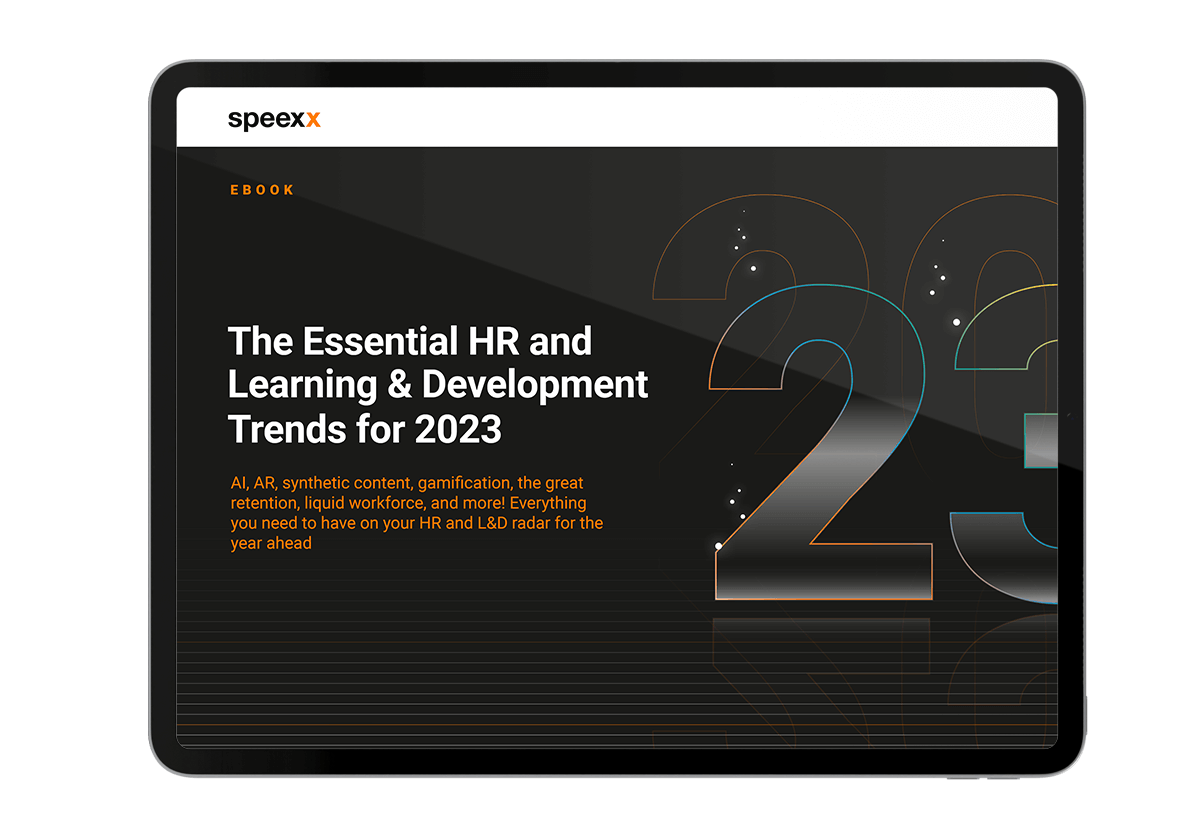
What will be hot in workplace L&D in 2023?
What are the key learning and development trends for this year?
And which challenges will companies face in L&D moving into what seems like a whole new era?
Find out more in the latest analysis from the annual L&D Global Sentiment Survey.
In recent years, the survey has gathered nearly 16,000 entries from over 100 countries and leveraged results into numbers, statistics, and forecasts. This year alone, almost 4,000 L&D experts from 97 different countries across the world have contributed their viewpoints on what matters most in the Learning and Development arena in 2023.
For decades, the learning and development segment has claimed a key role in corporate environments. Companies that provide their employees with opportunities for reskilling and upskilling are certain to reap multiple benefits, as the learning and development approach has become an essential element of contemporary corporate structure.
L&D trends 2023 – The Global Sentiment Survey
During our Masterclass Webinar with L&D Expert Donald H Taylor, we presented the key findings from the latest L&D Global Sentiment Survey of 2023, and more importantly, the possibility of a new era in L&D. With over 150 participants from various regions of the world, this was a great opportunity to gain valuable insights and discuss them in a professional setting.
The primary overarching trend for 2023 is placing individuals at the center of learning, which involves considering their unique needs, diverse skill sets, and personal characteristics. In other words companies should support the reskilling and upskilling of their employees. Maybe even in the sector of artificial intelligence, as there is a growing interest in AI-Technology and how to use it. Companies are faced with fundamental questions regarding if and how they will implement machine learning tools, like ChatGPT and Jasper, into their daily work process.
Hot L&D trends 2023 – an international survey with L&D experts from 100 countries
The L&D Global Sentiment Survey collects opinions and insights from experts around the world to identify trends and core areas in workplace learning. This year’s survey received almost 4000 responses (3.996 to be exact) from L&D specialists in 100 countries, including over 20% of the entries coming from all part of Asia. With only 3% Africa is the least represented, followed by Oceanian and South America with 7%. It is important that all continents are represented, because the wider the survey is distributed, the more diverse are the answers. Opinions can vary widely across the globe as well as between regions, and the contrast in opinions between South America and North and Central America is quiet huge.
The survey aims to help companies and L&D experts make informed decisions based on emerging trends and forecasts, providing a sound foundation for strategic planning. The results are presented annually in front of an international audience, offering fascinating insights into people’s thinking and serving as a useful resource for identifying trends for the upcoming year.
Geographic L&D trends
In recent years, the L&D survey has effectively highlighted both international trends and regional nuances in workplace learning. While the survey results indicate a clear inclination towards personalized, adaptive, and sustainable learning structures, there are notable differences in approaches that can be attributed to regional peculiarities.
Last year, reskilling/upskilling was the top option on the survey, with 13% of the vote, and received uniform support from all regions worldwide. However, this year, the trend is declining, with a drop of 0.5%, and it would have been even greater if not for the support from Southeast Asia. While reskilling/upskilling is still considered important, it no longer dominates the survey as it once did.
Geography plays a significant role in the survey results, with opinions varying widely across the globe and between regions. South America consistently ranks collaborative/social learning as the top option, while North America consistently places it at the bottom of the list. In contrast, North America ranks artificial intelligence as the top option, while South America ranks it at #9. These consistent differences between continents highlight the stark contrast in opinions.
Top 3 L&D trends of 2023: Reskilling/upskilling, skills-based talent management, and AI
AI has had an extraordinary impact on this year’s rankings, rising an unprecedented 4.5% to #2, which is the greatest jump ever seen in the survey. This jump is even more significant when we consider that options in decline almost never bounce back. While this increase was undoubtedly driven by ChatGPT’s offer of free access to powerful AI, L&D’s recent interest in AI predates ChatGPT.
The rise of AI is not the only trend highlighted in this year’s survey, as skills-based talent management rose 1.8% to #3, and Learning analytics reversed its previous decline with a rise of 0.4% to #4. These results suggest a shift in mindset towards the idea that data can be powerfully applied for the benefit of L&D. On the other hand, collaborative/social learning, which was one of the few success stories of the pandemic, is down 2.1% from #2 to #5.
Additionally, reskilling/upskilling, which dominated the table at #1 with 13% when introduced in 2021, continues to decline this year, dropping 0.5% from last year. While it is still considered important, it no longer dominates as it once did.

You missed the webinar? Watch the Recording!
How AI is transforming the way we live and work
“AI is too powerful to not take it seriously,” says L&D expert Donald H Taylor.
The impact of artificial intelligence on the professional and educational environment is undeniable, as it will change how we process data, analyse information and tackle day to day tasks. AI is revolutionizing how businesses and organizations operate, from automating processes to identifying patterns in large datasets. As AI technology continues to advance and become more widespread, it’s important for people in a professional setting to form strong opinions about what it can offer and learn how to use AI for their benefit. To do this effectively, individuals must understand AI’s capabilities so they can come up with creative applications that leverage its impressive capabilities.
“No matter if you like it or not, we need to have a position about it, backed up by facts and information. And we need to learn how to use and implement it.“ says Donald H Taylor in the Masterclass Webinar.
With the right implementation and understanding of AI, companies will be able to save time, increase accuracy of decisions, reduce costs associated with manual labor and enhance collaboration between employees. Moreover, by applying machine learning algorithms on large datasets of customer interactions, organizations can better understand customer preferences and create tailored products or services that better serve their needs. Ultimately, embracing AI technology is key for any business looking to stay competitive in the future marketplace. Therefore, those who don’t learn how to take advantage of the opportunities presented by AI risk falling behind, while those who embrace it could open up new avenues for innovation that give them an edge over their competition.
But is AI just a temporary hype or does it has some serious potential to get the new big thing?
Donald H Taylor has a very strong opinion about it and shares it during our Webinar: “It’s dangerous to predict the future, but I’m going to anyway. I think it is absolutely fundamental and it will change the way we do things, including work and learning. I’ve been doing this job of Learning and Developing and technology for a very long time. I started programming computers back in 1981. And there are two things that have happened in my lifetime that had fundamentally changed how we work, how we live and how we learn. One of them is the introduction of the World Wide Web. AI, I’m convinced, is on the same page. It’s the second thing that has a huge impact on how we live and work. My view is that it is absolutely fundamental and will change everything. I don’t say this lightly but there is just to much power into it for us to not take it seriously “
Biggest L&D challenges of 2023: budget, engagement, and value
Organizations are facing new challenges due to ever-changing living and working conditions, making it difficult for them to prioritize their efforts. L&D experts have identified several big challenges in 2023, including budget allocation, showing value to stakeholders, talent, and skills support & delivery. In addition, incentivizing employee engagement is seen as a critical area of concern. Companies are seeking to understand how to motivate and support their employees effectively, optimize resource utilization, and establish and nurture hybrid working models.
In response to the question “What is your biggest L&D challenge in 2023?,” 40% of the 1,615 respondents, who provided comments primarily in English, but also in Mandarin, Spanish, French, and Ukrainian, cited these concerns. The analysis conducted so far reveals a shift from last year, with more comments on impact, value, and budget, and fewer on content and adapting to a post-COVID world. However, the need to engage stakeholders remains a consistent trend from last year.
Three words that really stood out this year are value, impact, and budget. People seem to be much more stressed and concerned about resources and budget than in the previous years. “I have a small budget”, “Money! Learning budget being reduced” and “Budget – next year we’ll have limited budget,” are just some of the answers collected in the survey. Donald adds: “People want to make sure the money they are spending is providing an impact, we have always been concerned about showing value and consulting more deeply with the business. Will this be more of a trend? Possibily.”

AI, AR, gamification, employee engagement, the liquid workforce, and more. We tell you what trends and technologies to keep an eye on in 2023.
6 steps how to to use data
In today’s business world, data is the language of business and has become an essential element for companies to showcase their value and influence stakeholders. However, utilizing data in the right way is crucial for companies to achieve their goals. Donald H Taylor has shared six important steps to help organizations use data effectively.
1. Form your question
2. Learn where the relevant data is
3. Get permission to access the data
4. Make it trust-worthy
5. Query the data
6. Re-form your question
By following these steps, organizations can gain a deeper understanding of their business and make informed decisions based on the data they collect. Start small and use one set of questions. If you are doing it right, that question will grow into another question. You might start with learning data but it will later be in your interest how it effects business data. The key is to keep asking the right questions and utilizing the insights gained from data analysis to drive business success.
L&D shifting focus from collaborative learning to AI and data
In recent years, the L&D landscape has seen a shift from a focus on collaborative learning to a fascination with the use of data, particularly in the field of AI. This shift has been so significant that it’s almost as if the pandemic never happened. While collaborative learning was on the rise in 2021 and 2022, L&D professionals are now more interested in the use of data for learning and development.
The power of AI and the ability to handle data have grown hugely more sophisticated over the years, and the launch of ChatGPT has triggered an AI arms race between tech giants and agile start-ups. However, the question remains: has L&D kept pace with the advancements in AI and data, or are they destined to play catch up?
“In the future we will work with machines. Machines are really good at standardizing stuff, we as human beings are really good with other stuff. We are really good at being creative, thinking about stuff and coming up with answers, that machines can’t. You can’t have an algorithm that puts together two unusual ideas in a new creative way. That requires a bit of knowledge and also a bit of creative problem solving, that AI will never be able to do, unless it generalise AI and then we are in trouble. So far what that means is, that humans have to lead the process, AI Tools support us” says Donald H Taylor.
As we move forward, the growth of AI and data is expected to continue at an exponential rate, posing a significant challenge for L&D professionals. The question now is whether L&D can master the use of AI and data to enhance learning and development in the years to come.


